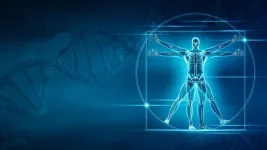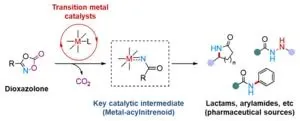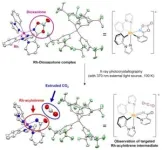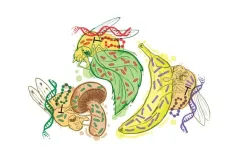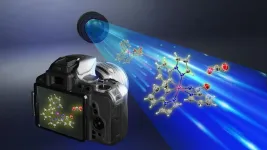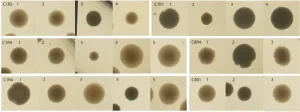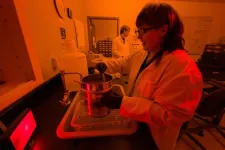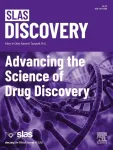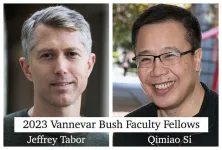(Press-News.org) Using artificial intelligence to analyze tens of thousands of X-ray images and genetic sequences, researchers from The University of Texas at Austin and New York Genome Center have been able to pinpoint the genes that shape our skeletons, from the width of our shoulders to the length of our legs.
The research, published as the cover article in Science, pulls back a curtain on our evolutionary past and opens a window into a future where doctors can better predict patients’ risks of developing conditions such as back pain or arthritis in later life.
“Our research is a powerful demonstration of the impact of AI in medicine, particularly when it comes to analyzing and quantifying imaging data, as well as integrating this information with health records and genetics rapidly and at large scale,” said Vagheesh Narasimhan, an assistant professor of integrative biology as well as statistics and data science, who led the multidisciplinary team of researchers, to provide the genetic map of skeletal proportions.
Humans are the only large primates to have longer legs than arms, a change in the skeletal form that is critical in enabling the ability to walk on two legs. The scientists sought to determine which genetic changes underlie anatomical differences that are clearly visible in the fossil record leading to modern humans, from Australopithecus to Neanderthals. They also wanted to find out how these skeletal proportions allowing bipedalism affect the risk of many musculoskeletal diseases such as arthritis of the knee and hip — conditions that affect billions of people in the world and are the leading causes of adult disability in the United States.
The researchers used deep learning models to perform automatic quantification on 39,000 medical images to measure distances between shoulders, knees, ankles and other points in the body. By comparing these measurements to each person’s genetic sequence, they found 145 points in the genome that control skeletal proportions.
“Our work provides a road map connecting specific genes with skeletal lengths of different parts of the body, allowing developmental biologists to investigate these in a systematic way,” said Tarjinder (T.J.) Singh, the study’s co-author, and associate member at NYGC and assistant professor in the Columbia University Department of Psychiatry.
The team also examined how skeletal proportions associate with major musculoskeletal diseases and showed that individuals with a higher ratio of hip width to height were found to be more likely to develop osteoarthritis and pain in their hips. Similarly, people with higher ratios of femur (thigh bone) length to height were more likely to develop arthritis in their knees, knee pain and other knee problems. People with a higher ratio of torso length to height were more likely to develop back pain.
“These disorders develop from biomechanical stresses on the joints over a lifetime,” said Eucharist Kun, a UT Austin biochemistry graduate student and lead author on the paper. “Skeletal proportions affect everything from our gait to how we sit, and it makes sense that they are risk factors in these disorders.”
The results of their work also have implications for our understanding of evolution. The researchers noted that several genetic segments that controlled skeletal proportions overlapped more than expected with areas of the genome called human accelerated regions. These are sections of the genome shared by great apes and many vertebrates but are significantly diverged in humans. This provides genomic rationale for the divergence in our skeletal anatomy.
One of the most enduring images of the Rennaisance—Leonardo Da Vinci’s “The Vitruvian Man” –contained similar conceptions of the ratios and lengths of limbs and other elements that make up the human body.
“In some ways we’re tackling the same question that Da Vinci wrestled with,” Narasimhan said. “What is the basic human form and its proportion? But we are now using modern methods and also asking how those proportions are genetically determined.”
In addition to Kun and Narasimhan, the co-authors are Tarjinder Singh of the New York Genome Center and Columbia University; Emily M. Javan, Olivia Smith, Javier de la Fuente, Brianna I. Flynn, Kushal Vajrala, Zoe Trutner, Prakash Jayakumar and Elliot M. Tucker-Drob of UT Austin; Faris Gulamali of Icahn School of Medicine at Mount Sinai; and Mashaal Sohail of Universidad Nacional Autonoma de Mexico. The research was funded by the Allen Institute, Good Systems, the Ethical AI research grand challenge at UT Austin, and the National Institutes of Health, with graduate student fellowship support provided by the National Science Foundation and UT Austin’s provost’s office.
END
Genes that shape bones identified, offering clues about our past and future
An application of AI to medical imaging datasets has revealed genetics of the skeletal form for the first time
2023-07-20
ELSE PRESS RELEASES FROM THIS DATE:
Immune systems develop ‘silver bullet’ defences against common bacteria
2023-07-20
Immune systems develop specific genes to combat common bacteria such as those found in food, new research shows.
Previous theories have suggested that antimicrobial peptides – a kind of natural antibiotics – have a general role in killing a range of bacteria.
However, the new study, published in Science, examined how the immune systems of fruit flies are shaped by the bacteria in their food and environment.
The researchers, from the Swiss Federal Institute of Technology and the University of Exeter, found two peptides that each control a single bacterial species commonly encountered by the flies.
“We know that an animal’s food and environment ...
These bones were made for walking
2023-07-20
NEW YORK, NY--Perhaps the most profound advance in primate evolution occurred about 6 million years ago when our ancestors started walking on two legs. The gradual shift to bipedal locomotion is thought to have made primates more adaptable to diverse environments and freed their hands to make use of tools, which in turn accelerated cognitive development. With those changes, the stage was set for modern humans.
The genetic changes that made possible the transition from knuckle-based scampering in great apes to upright walking in humans have now been uncovered in a new study by researchers ...
Observing the long-postulated intermediate of catalytic amination reactions
2023-07-20
Led by Director CHANG Sukbok, scientists from the Center for Catalytic Hydrocarbon Functionalizations within the Institute for Basic Science (IBS) have made a breakthrough in understanding the structure and reactivity of a key intermediate in catalytic reactions. This intermediate, known as a transition metal-nitrenoid, plays a crucial role in converting hydrocarbons into amides, which are important in pharmaceuticals and materials science.
In chemical reactions, intermediates are substances that are formed and consumed during the transformation of reactants into products. Hence, understanding these intermediates ...
Living together: Microbial communities are more than the sum of their parts
2023-07-20
Microbial communities are widely used biotechnology suppliers for processes like manufacturing biofuels and new foods, or helping crops grow better. To engineer successful communities, scientists need to predict whether microorganisms can live and work together. One popular predictive rule states that if a pair of microbes will coexist, they will also coexist in a bigger community of microbes. A study published in Science now found that this simple rule will not always work.
Just like plants and animals, microorganisms live in complex ecological communities consisting of multiple species that ...
Greenland has greener history than previously thought, says USU Geoscientist
2023-07-20
LOGAN, UTAH, USA -- New analysis of samples collected from underneath Greenland’s ice sheet reveal the Arctic island was much greener as recently as 416,000 years ago. The findings overturn previous views that Greenland’s continental glacier, which covers about 80 percent of the 836,3000-square-mile land mass, has persisted for the last two and a half million years.
“We’re discovering the ice sheet is much more sensitive to climate change than we previously thought,” says Utah State University geoscientist ...
New advancements in assay development research
2023-07-20
Oak Brook, IL – The July 2023 issue of SLAS Discovery, the open access journal focused on research progressing drug discovery, is now available. Volume 28, Issue 5, contains one short communication and four full-length articles covering assay quality metrics, fluorescence resonance energy transfer (FRET) and small molecule glycomimetics and other high-throughput screening-related research.
Full-length articles
Mathematical relationships between control group variability and assay quality metrics
Authored by early ...
The present and future of computing get a boost from new research
2023-07-20
The world's computing needs have grown exponentially in recent years due to an explosion of technology. To meet the needs for the next technological leap, the scientific community is working to improve current processing capabilities and simultaneously develop entirely new computing methods.
Two new papers from the research group of Jean Anne Incorvia, a professor in the Cockrell School of Engineering’s Chandra Family of Electrical and Computer Engineering, aim to contribute to both of these scientific needs. Together, they offer improvements ...
The largest study of its kind shows a need for improvement in esophageal cancer screenings
2023-07-20
A new study published in Gastroenterology aims to improve the effectiveness of screening and surveillance practices for early cancer detection in Barrett’s esophagus (BE).
BE is the only identifiable precursor lesion for esophageal adenocarcinoma (EAC), a lethal cancer with increased incidence and mortality rates over the last several decades.
The research, led by faculty at the University of Colorado (CU) Cancer Center, analyzed a large international database of over 20,000 newly diagnosed BE patients in Nordic countries to provide a more accurate look at how many patients have normal ...
Damon Runyon Cancer Research Foundation awards $3.6 million to top clinical investigators
2023-07-20
The Damon Runyon Cancer Research Foundation has named six new Damon Runyon Clinical Investigators. The recipients of this prestigious award are outstanding, early-career physician-scientists conducting patient-oriented cancer research at major research centers under the mentorship of the nation's leading scientists and clinicians.
The Clinical Investigator Award program was designed to increase the number of physicians capable of moving seamlessly between the laboratory and the patient’s ...
Rice researchers earn prestigious Defense Department grants
2023-07-20
HOUSTON – (July 20, 2023) – Rice University professors Qimiao Si and Jeffrey Tabor, are recipients of prestigious Vannevar Bush Faculty Fellowships from the United States Department of Defense.
Si, a theoretical quantum physicist, and Tabor, a bioengineer and synthetic biologist, are among 10 members of the 2023 class of Bush fellows named by the department’s Basic Research Office.
The highly competitive, five-year fellowships are among the federal government’s most prestigious individual research honors. Bush fellowships are awarded annually and include $3 million to pursue ...
LAST 30 PRESS RELEASES:
Magnetic avalanches power solar flares
LeapSpace goes live: the Research-Grade AI-Assisted Workspace built on trusted science
DNA tests reveal mysterious beluga family trees
Strategic sex: Alaska’s beluga whales swap mates for long-term survival
How early cell membranes may have shaped the origins of life
Cannabis legalization is driving increases in marijuana use among U.S. adults with historically lower consumption rates
Multifunctional dipoles enabling enhanced ionic and electronic transport for high‑energy batteries
Triboelectric nanogenerators for future space missions
Advancing energy development with MBene: Chemical mechanism, AI, and applications in energy storage and harvesting
Heteroatom‑coordinated Fe–N4 catalysts for enhanced oxygen reduction in alkaline seawater zinc‑air batteries
Meta-device for precision lateral displacement sensing
Plasma-guided mitotane for the treatment of adrenocortical carcinoma: adjuvant care to advanced disease
Theoretical study of laser-enhanced nuclear fusion reactions
Social environment impacts sleep quality
Optimized kinetic pathways of active hydrogen generation at Cu2O/Cu heterojunction interfaces to enhance nitrate electroreduction to ammonia
New design playbook could unlock next generation high energy lithium ion batteries
Drones reveal how feral horse units keep boundaries
New AI tool removes bottleneck in animal movement analysis
Bubble netting knowledge spread by immigrant humpback whales
Discovery of bats remarkable navigation strategy revealed in new study
Urban tributaries identified as major sources of plastic chemical pollution in the Yangtze River
UK glaucoma cases higher than expected and projected to reach 1.6 million+ by 2060
Type 2 diabetes prevention could more than halve carbon footprint linked to disease complications
Over 1 million estimated to have glaucoma in UK
Early treatment can delay rheumatoid arthritis for years
National childhood type 1 diabetes screening is effective and could prevent thousands of emergency diagnoses, UK study shows
Mix of different types of physical activity may be best for longer life
Continuous care from community-based midwives reduces risk of preterm birth by 45%
Otago experts propose fiber as first new essential nutrient in 50 years
Auburn Physics PhD student earns prestigious DOE Fellowship
[Press-News.org] Genes that shape bones identified, offering clues about our past and futureAn application of AI to medical imaging datasets has revealed genetics of the skeletal form for the first time
